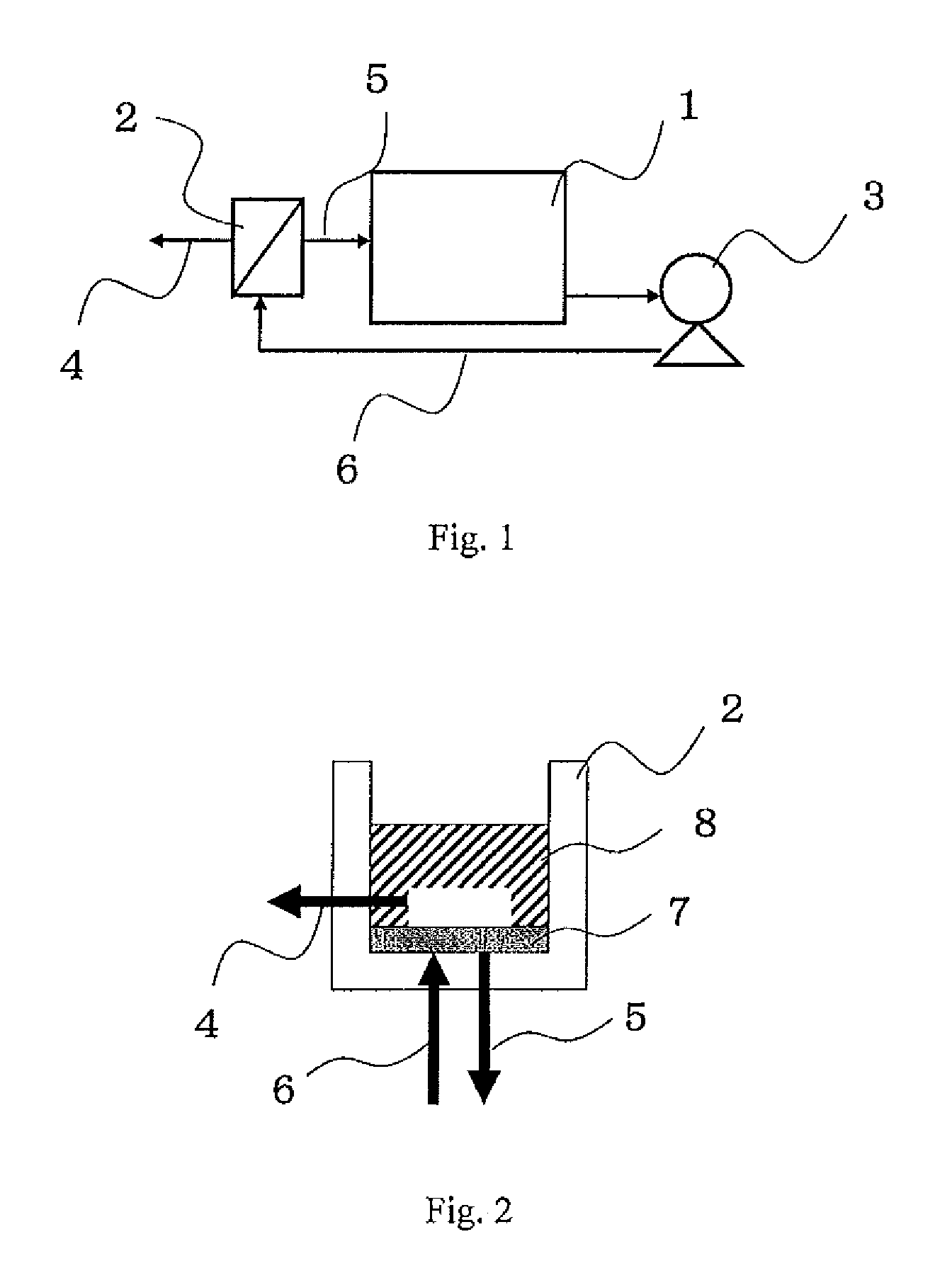Method of producing diol or triol
a technology of diol or triol and diol or triol, which is applied in the preparation of oxygen-containing compounds, oxygen-containing compounds, purification/separation of oxygen compounds, etc., can solve the problems of reducing yield, increasing cost, and not revealing the effect of nanofiltration membrane material difference on permeation selectivity and purity, so as to achieve higher purity and recover more efficiently
- Summary
- Abstract
- Description
- Claims
- Application Information
AI Technical Summary
Benefits of technology
Problems solved by technology
Method used
Image
Examples
reference example 1
Evaluation of Permeability of Nanofiltration Membrane to Diol and Triol
[0060]To 10 L of ultrapure water, 10 g of ethylene glycol, 1,3-propanediol, 2,3-butanediol, glycerin, 1,3-butanediol or 1,4-butanediol (all of which were manufactured from Wako Pure Chemical Industries, Ltd.) was added, and the resulting mixture was stirred at 25° C. for 1 hour, thereby preparing 1000 ppm aqueous diol or trial solution. Subsequently, 10 L of the thus prepared aqueous diol or triol solution was fed to a feed tank 1 of the membrane filtration apparatus shown in FIG. 1. As the 90φ nanofiltration membrane indicated by Symbol 7 in FIG. 2, each of a cross-linked piperazine polyamide nanofiltration membrane “UTC60” (nanofiltration membrane 1; manufactured by TORAY INDUSTRIES, INC.), a polyamide nanofiltration membrane “NF99” (nanofiltration membrane 2, manufactured by Alfa-Laval), a cross-linked piperazine polyamide nanofiltration membrane “NF-400” (nanofiltration membrane 3; manufactured by FilmTec Cor...
reference example 2
Evaluation of Rejection Rate of Nanofiltration Membrane against Inorganic Salt (Magnesium Sulfate)
[0065]To 10 L of ultrapure water, 10 g of magnesium sulfate (manufactured by Wake Pure Chemical Industries, Ltd.) was added, and the resulting mixture was stirred at 25° C. for 1 hour, to prepare 1000 ppm aqueous magnesium sulfate solution. Subsequently 10 L of the prepared aqueous magnesium sulfate solution was fed to the feed tank 1, followed by collecting the permeate from each of the nanofiltration membranes 1 to 4 under the same conditions as in Reference Example 1. The concentration of magnesium sulfate in each of the feed tank 1 and the permeate 4 was analyzed with an ion chromatography (manufactured by Dionex Corporation) under the following conditions, thereby calculating the rejection rate of the magnesium sulfate.
[0066]Anion; column (AS4A-SC (manufactured by Dionex Corporation)), eluent (1.8 mM sodium carbonate / 1.7 mM sodium hydrogen carbonate), temperature (35° C.).
[0067]Cat...
examples 1 to 9
Purification of 1,3-Propanediol from Fermentation Broth Using Nanofiltration Membrane
[0071]A budding yeast strain NBRC10505 was cultured as follows. In terms of the culture medium, 2 L of a culture medium containing 60 g / L Yutosei (manufactured by MUSO Co., Ltd.) and 1.5 g / L ammonium sulfate was prepared and then autoclaved (121° C., 15 minutes).
[0072]First, the yeast NBRC10505 strain was cultured overnight with shaking in a test tube containing 5 ml of the culture medium (pre-preculture). The pre-preculture broth was inoculated to 100 ml of a fresh lot of the medium, and culture was carried out in a 500-ml Sakaguchi flask for 24 hours with shaking (preculture). Culture was carried out while adjusting temperature and pH. The operating conditions of the jar fermenter were as shown below.
[0073]Reaction vessel volume (amount of medium), 2 (L); temperature adjustment, 30 (° C.); ventilation volume for the reaction vessel, 0.2 (L / min.); stirring rate of the reaction vessel, 400 rpm; pH a...
PUM
| Property | Measurement | Unit |
|---|---|---|
| temperature | aaaaa | aaaaa |
| temperature | aaaaa | aaaaa |
| pressure | aaaaa | aaaaa |
Abstract
Description
Claims
Application Information
 Login to View More
Login to View More - R&D
- Intellectual Property
- Life Sciences
- Materials
- Tech Scout
- Unparalleled Data Quality
- Higher Quality Content
- 60% Fewer Hallucinations
Browse by: Latest US Patents, China's latest patents, Technical Efficacy Thesaurus, Application Domain, Technology Topic, Popular Technical Reports.
© 2025 PatSnap. All rights reserved.Legal|Privacy policy|Modern Slavery Act Transparency Statement|Sitemap|About US| Contact US: help@patsnap.com



